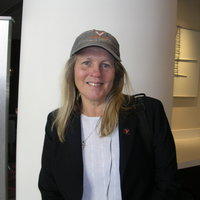Question for Montoya: Will successful treatment of CFS with AIDS drug hint that CFS and AIDS are related?
Ruxolitinib and Tofacitinib Are Potent and Selective Inhibitors of HIV-1 Replication and Virus Reactivation In Vitro
ABSTRACT
The JAK-STAT pathway is activated in both macrophages and lymphocytes upon human immunodeficiency virus type 1 (HIV-1) infection
and thus represents an attractive cellular target to achieve HIV suppression and reduced inflammation, which may impact virus
sanctuaries. Ruxolitinib and tofacitinib are JAK1/2 inhibitors that are FDA approved for rheumatoid arthritis and myelofibrosis,
respectively, but their therapeutic application for treatment of HIV infection was unexplored. Both drugs demonstrated submicromolar
inhibition of infection with HIV-1, HIV-2, and a simian-human immunodeficiency virus, RT-SHIV, across primary human or rhesus
macaque lymphocytes and macrophages, with no apparent significant cytotoxicity at 2 to 3 logs above the median effective antiviral
concentration. Combination of tofacitinib and ruxolitinib increased the efficacy by 53- to 161-fold versus that observed for
monotherapy, respectively, and each drug applied alone to primary human lymphocytes displayed similar efficacy against HIV-1
containing various polymerase substitutions. Both drugs inhibited virus replication in lymphocytes stimulated with phytohemagglutinin
(PHA) plus interleukin-2 (IL-2), but not PHA alone, and inhibited reactivation of latent HIV-1 at low-micromolar concentrations
across the J-Lat T cell latency model and in primary human central memory lymphocytes. Thus, targeted inhibition of JAK provided
a selective, potent, and novel mechanism to inhibit HIV-1 replication in lymphocytes and macrophages, replication of drug-resistant
HIV-1, and reactivation of latent HIV-1 and has the potential to reset the immunologic milieu in HIV-infected individuals.
The Janus kinase inhibitor ruxolitinib reduces HIV replication in human macrophages and ameliorates HIV encephalitis in a murine model.
Neurobiol Dis. 2016; 92(Pt B):137-43 (ISSN: 1095-953X)
Haile WB; Gavegnano C; Tao S; Jiang Y; Schinazi RF; Tyor WR
A hallmark of persistent HIV-1 infection in the central nervous system is increased activation of mononuclear phagocytes and surrounding astrogliosis, conferring persistent HIV-induced inflammation. This inflammation is believed to result in neuronal dysfunction and the clinical manifestations of HIV-associated neurocognitive disorders (HAND). The Jak/STAT pathway is activated in macrophages/myeloid cells upon HIV-1 infection, modulating many pro-inflammatory pathways that result in HAND, thereby representing an attractive cellular target. Thus, the impact of ruxolitinib, a Janus Kinase (Jak) 1/2 inhibitor that is FDA approved for myelofibrosis and polycythemia vera, was assessed for its potential to inhibit HIV-1 replication in macrophages and HIV-induced activation in monocytes/macrophages in culture. In addition, a murine model of HIV encephalitis (HIVE) was used to assess the impact of ruxolitinib on histopathological features of HIVE, brain viral load, as well as its ability to penetrate the blood-brain-barrier (BBB). Ruxolitinib was found to inhibit HIV-1 replication in macrophages, HIV-induced activation of monocytes (CD14/CD16) and macrophages (HLA-DR, CCR5, and CD163) without apparent toxicity. In vivo, systemically administered ruxolitinib was detected in the brain during HIVE in SCID mice and markedly inhibited astrogliosis. Together, these data indicate that ruxolitinib reduces HIV-induced activation and infiltration of monocytes/macrophages in vitro, reduces the replication of HIV in vitro, penetrates the BBB when systemically administered in mice and reduces astrogliosis in the brains of mice with HIVE. These data suggest that ruxolitinib will be useful as a novel therapeutic to treat humans with HAND.
https://www.medscape.com/medline/abstract/26851503
1. Is Dr. Montoya treating Chronic Fatigue Syndrome as a kind of low natural killer syndrome, which is what the Japanese said it was decades ago?
2. What is the cause of the inflammation he is treating? Is it the "Fifty Shades of AIDS viruses"(HHV-6/7/8)?
3. Will Tofacitinib be the breakthrough drug for the inflammation caused in CFS by the "Fifty Shades of AIDS viruses" (HHV-6/7/8)?
The definitive history of the
Chronic Fatigue Syndrome cover-up.
As the publisher and editor-in-chief of a small newspaper in New York, Charles Ortleb was the first journalist to devote a publication to uncovering the truth about Chronic Fatigue Syndrome. He assigned Neenyah Ostrom the duty of following every twist and turn of the Chronic Fatigue Syndrome story. No newspaper in the world did more to warn the world about the virus called HHV-6 which seems to be triggering Chronic Fatigue Syndrome and many other immunological disorders.This provocative book will end the injustice of the silent treatment Neenyah Ostrom's reporting has been getting from the media and The Chronic Fatigue Syndrome community. Ostrom blew the lid off one of the biggest medical secrets of our time: the link between the Chronic Fatigue Syndrome epidemic and AIDS.
Ostrom interviewed most of the major researchers in the field, as well as countless patients and government scientists. She uncovered so many similarities between Chronic Fatigue Syndrome and AIDS that she came to the conclusion that they are part of the same epidemic, and she argued that until their connection is admitted by top government researchers, there is little hope of making real progress in the fight against Chronic Fatigue Syndrome.
Charles Ortleb's book captures all the challenges and excitement of running a small newspaper that was publishing a brilliant journalist who essentially was the Woodward and Bernstein of the Chronic Fatigue Syndrome epidemic. In Rolling Stone, David Black said Ortleb's newspaper deserved a Pulitzer Prize.










